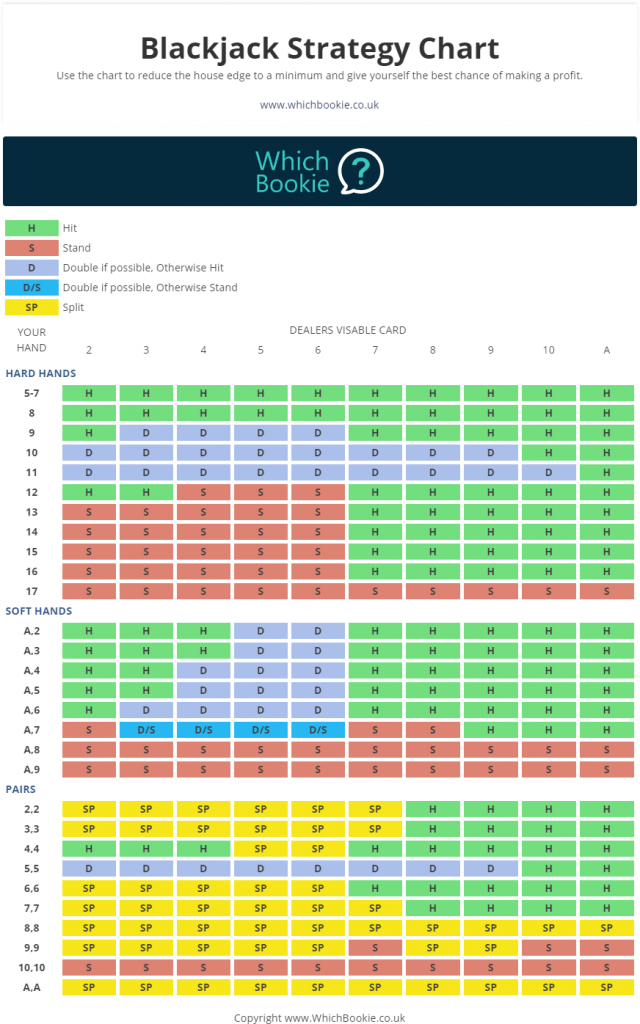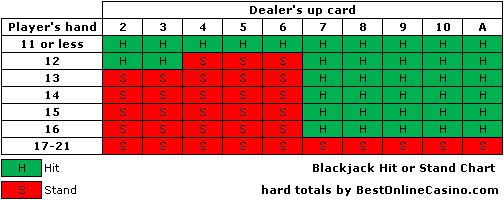- Hit And Stand
- Hit Or Stand Blackjack
- How To Know When To Hit Or Stand In Blackjack
- Blackjack Hit Stand Chart
Hard 14 is always a stand when the dealer exposes small cards 2 through 6. The player must hit their hard 14 against all other upcards, namely 7 through ace. When dealt A-3, you have a soft 14. After the cards are dealt, you have the option to Hit, Stand, Double, or Split. Because this game is a trainer, it is up to you to add the cards and know whether you are allowed to split or double. Here are some situations when you should definitely stand in Blackjack: If you have a hard 17-20, always stand – most dealers play soft 17, which means they stop hitting when they get as much as an Ace.
We need to talk about a couple of things first, in order to jog your memory. HIT is a term that means the player is asking for one more card. And STAND means “no more cards”, simply put. Deciding which one to use and when is the key to winning at blackjack online games. A SOFT TOTAL means that you have an Ace. A HARD TOTAL means that you have no Ace. With two Aces in blackjack you can have either a 2 or a soft 12.
Before we start, don’t forget that whether to hit or stand is a decision that should be made according to the rules that bind the dealer: If the dealer has to stand on soft 17, for example, the calculations will be different. So, always check what are the dealer rules first.
And if you are asking when does the dealer stand or hit in blackjack orwhen does the dealer stop hitting in blackjack? it is different in each game: You can just look on top of the table, this rule is clearly explained on it. (And if you are wondering blackjack casino soft 17 hit or stand which is more common, we can say that the “stand” version is more common.) So, are we ready? Let’s start with the hit or stand charts, because they will explain the situation much better.

My mom taught me how to play blackjack when I was a little kid. The strategy she taught me addressed when you should hit or stand in blackjack in simple terms.
She taught me to stand if I had a total of 16 or higher, and to hit if I had a total of 15 or lower.
If you know anything about blackjack basic strategy at all, you’ll know that her strategic advice was off-base, to say the least.
In this post, I’ll answer the question, “When should you hit or stand in blackjack?” in some degree of detail. Keep reading below to learn a few blackjack tips.
What Does It Mean to Hit or Stand?
The two basic moves in blackjack are to hit or to stand, although you have some other options. You might think everyone knows that, but you’d be surprised. A friend of mine took a date to the casino not too long ago, and she asked him what she should do next.
When he told her to “stand,” she didn’t necessarily understand what that meant for the game. So, no, not everyone knows what it means to hit or to stand.
For those folks, here’s a quick explanation of blackjack and the moves you can make during the game.
- You get two cards, and so does the dealer. The dealer has one card face-up and one card face-down.
- The cards are worth points based on their ranking. The numeric cards are worth their number. So, the seven of spades is worth 7 points. The face cards (the jacks, queens, and kings) are each worth 10 points. An ace is worth 1 or 11 points, whichever works out better for the hand.
- Your total score is the point value of the cards added together.
The higher total wins the bet, but there’s a catch. If you get a total of 22 or higher, you bust, which is an automatic loss.
When you play your hand, your basic moves are simple. You can “hit,” which means to get another card. Or you can “stand,” which means to forego any other cards and let the dealer play their hand.
The Implications of Going Bust
Since the blackjack player goes first, it’s important to avoid busting your hand if you can. Once you bust, you lose your bet, even though the dealer hasn’t played her hand yet.
The higher your total, the higher the probability that the next card will bust your hand.
If you have a total of 10, for example, it’s impossible to bust. The highest value card you can get is 11, which would give you a total of 21—the best possible point total you could have.
If you have a total of 11, it’s still impossible to bust. The only card worth 11 can also count as 1, so you’d never stand on a total of 10 or 11.
With a total of 12, you now start having a possibility of going bust… Which cards will bust a total of 12? Any card that’s nine or lower will improve your total, but any card worth 10 is going to bust you.
How many cards are worth nine or less? You have the following cards which could help your hand, and there are four of each of them:

- Aces
- 2s
- 3s
- 4s
- 5s
- 6s
- 7s
- 8s
- 9s
That’s 36 cards that will help you. There are also 16 cards worth 10 points in the deck—the 10s, jacks, queens, and kings. Those will bust you.
16/52 is the same thing as 4/13, which is slightly less than 1/3. If a card is going to help you almost 2/3 of the time, it’s probably a good idea to take that card.
Some More Examples of Totals and Possible Bust Cards
Suppose you have a higher total, though. Let’s say you have a total of 16, for example.
How many cards will help you in this situation?
- Aces
- 2s
- 3s
- 4s
- 5s

That’s 20 cards out of 52 which will help you, which leaves 32 cards which will bust your hand.
A lot of people always stand on 16, even though mathematically, that’s not always the correct move.
Hit And Stand
If blackjack were as simple as calculating the probability of going bust, everyone would know which moves to make and when. You also need to account for the dealer’s face-up card.
The correct strategy with a total of 16 is to stand if the dealer is showing a card of six or lower, but you should hit if the dealer has a seven or higher showing. For this purpose, an ace is also considered a high card.
Yes, you’ll bust most of the time, but the dealer has a strong enough hand that you must be willing to risk this to get the best odds of winning. In fact, with every possible total, you must consider both your total and the dealer’s total when deciding whether to hit or stand.
Soft Hands vs. Hard Hands
Something else to consider when deciding whether to hit or stand is whether you have a hard total or a soft total. What’s the difference?
Remember how I explained that an ace counts as either 1 or 11 points? If you have a hand with an ace in it where you can count it as either without going bust, you have a soft hand.
If you must count the ace as 1 point to avoid busting, it’s a hard hand. You’ll hit more often with soft hands because you’ll have a lower probability of going bust.
Here’s an ExampleYou have an ace and a two. That’s a soft total of 13. If you get a 10 or a nine, you can just count the ace as a one instead of an 11, and you now have a total of 13 or 12, respectively.
You Do Have Other Options

Hitting and standing aren’t the only options you have. You can also make the following moves in blackjack.
You can split. If you get two cards of the same ranking, like two aces or a couple of eights, you can split your hand. This means you put up an additional bet and start two hands instead of one. These two hands play out independently.
You can double. Doubling down is the same thing as hitting, but with two differences:
- You must double the size of your bet.
- You can’t take any more cards after the first one.
You can surrender. If you hate your chances, you can surrender, which means you only lose half your bet. But you also have no chance of winning.
More About Basic Strategy in Blackjack

If you want to know the move in every situation with the best potential outcome in the long run, you’ll want to memorize basic strategy. Basic strategy was generated by running millions of hands through a simulator and determining which moves had the best expectation.
Most people learn basic strategy using a chart or a table. A table usually has the dealer’s possible up-cards listed across the top. The player’s possible totals are listed along the left-hand side.
You cross-index what you have with what the dealer has, and the table tells you what to do. The tricky thing about basic strategy is that the correct moves vary a little bit based on the conditions of the game you’re playing.
For example, basic strategy for a single deck game might be different in some situations from an eight-deck game. You can find multiple basic strategy generators on the internet, but for most recreational players, I recommend just learning a single basic strategy and sticking with it.
The difference in expected value from one game to another doesn’t usually change much regarding the handful of basic strategy differences based on game conditions.
Hit Or Stand Blackjack
And if you’re not counting cards, you’re playing a game with a house edge. No matter how big or small that edge is, you’ll eventually lose all your money in the long run.
What difference does it make if you lose it slightly faster?
Conclusion
When should you hit or stand in blackjack? When basic strategy tells you to!
How To Know When To Hit Or Stand In Blackjack
That’s the only correct answer to that question. I’ve tried to offer some examples of how that math works, but it’s more complicated than just looking at the probability of busting.
Blackjack Hit Stand Chart
You also need to account for the dealer’s possible outcomes.
Please enable JavaScript to view the comments powered by Disqus.